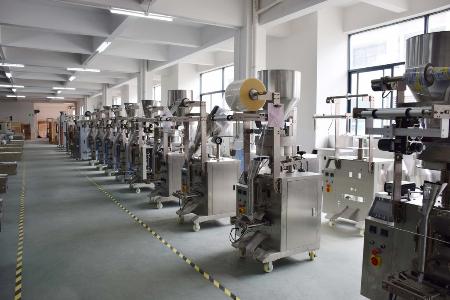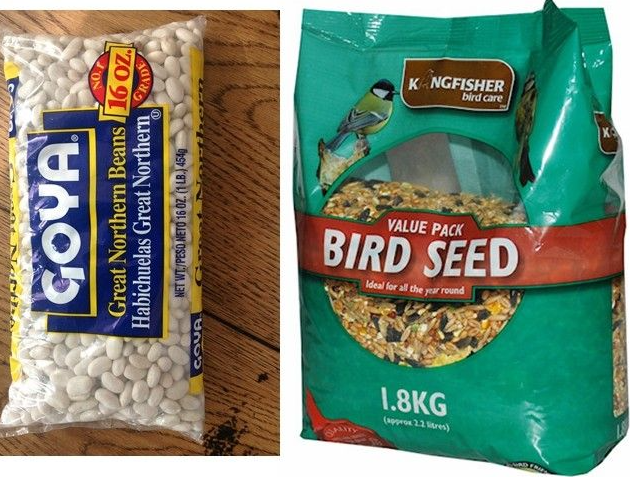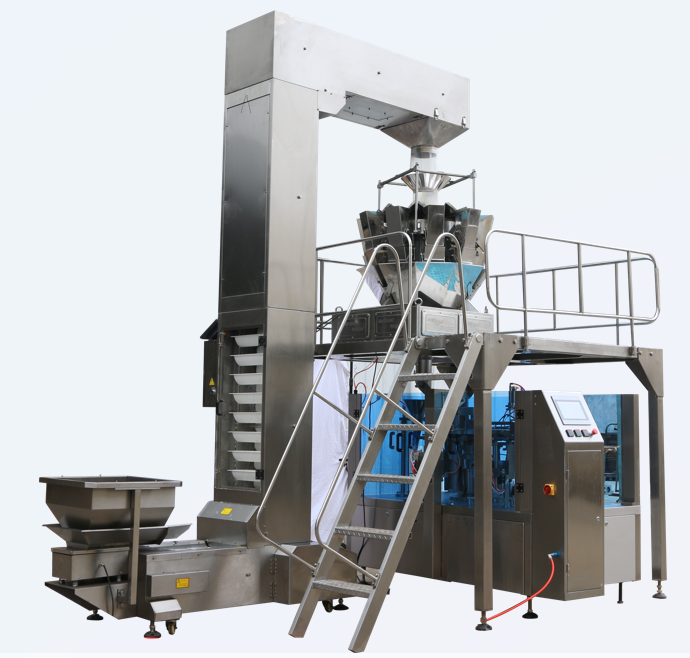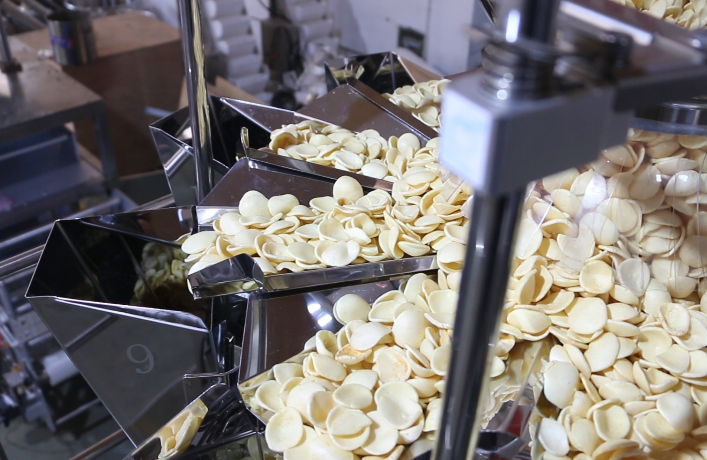
Allow me to introduce to you with unparalleled enthusiasm the mysterious phenomenon within potato chip packaging—gas filling! Yes, ladies and gentlemen, listen closely to this little secret: the gas within the packaging bags is not just ordinary air but nitrogen with special magical properties!
Recall, if you will, when you open a bag of potato chips, how they always seem so full and intact, as if they've never experienced any squeezing or crushing? That's because a substantial amount of nitrogen gas is filled into the packaging bags, a technique known as "gas filling packaging."

Nitrogen, this seemingly mundane gas, plays a crucial role in potato chip packaging. It effectively prevents the chips from breaking due to external pressure during transportation and sale, thus ensuring the quality and texture of the product.
However, you might wonder, why not simply use plastic packaging? Wouldn't that be easier? In reality, although plastic packaging is convenient, it cannot provide sufficient protection. During transportation and sale, potato chips are easily crushed due to external pressure, leading to a decrease in product quality and affecting the consumer's purchasing experience.
In contrast, gas filling packaging has clear advantages. Firstly, nitrogen has good stability and inertness, making it resistant to reactions with other substances, thus ensuring that the quality of the chips is not compromised. Secondly, nitrogen has a higher density, effectively resisting external impacts, keeping the chips intact during transportation and sale. Finally, the cost of nitrogen is relatively low, making it suitable for large-scale production and application.
Therefore, whether from the perspective of product quality or economic benefits, gas filling packaging is the preferred solution for the potato chip packaging industry. In the future, we believe that this technology will be more widely applied, providing consumers with a better shopping experience.
Through this blog, I hope to let more people understand the mystery of gas filling packaging and look forward to discussing the latest developments and innovative practices in this field with fellow professionals. Let's work together to promote the continuous progress and development of the potato chip packaging industry!
Let's explore together how to meticulously craft mouthwatering fried potato chips! This not only requires us to strive for excellence in every step but also requires strict control over raw materials. Only in this way can we ensure that our products have excellent quality and minimize waste.
Firstly, we need to select high-quality potatoes as our main raw material. These potatoes should have the following characteristics: regular tuber shape, medium and uniform size; thin and uniform skin color; few eyes; high density; rich in starch and total solids; low sugar content; and relatively stable soil environment for cultivation. Only then can we ensure that our potato chips are crispy and fragrant.
Next, we need to wash the potatoes. This process is crucial as it effectively removes dirt and impurities from the surface of the potatoes, reducing the risk of microbial contamination and pesticide residues. We will use a drum-type sorting machine to complete this task, ensuring that each potato receives thorough cleaning.
Next, we need to peel the potatoes. This step is crucial because the cellulose in potato skins can affect the taste of potato chips. We typically use a 10% sodium hydroxide solution to soften the potato skins, then easily remove them using rubber discs. This not only preserves the integrity of the potatoes but also saves a considerable amount of water resources, reduces product loss, and the resulting concentrated skin "paste" is also easier to handle in subsequent processes.
Following that, we need to slice the potatoes. This step requires us to adjust the thickness of the slices based on the harvesting season and storage time of the potatoes. Potatoes just harvested are plump and have high water content, so we control the slice thickness between 1.8-2.0 millimeters. For potatoes stored for a longer time with high evaporation of moisture and high solid content in tubers, we set the slice thickness between 1.6-1.8 millimeters.
After slicing, we need to clean the potato chips. This step is straightforward, simply gently rinsing the chips in clean water. This prevents starch from gelatinizing and adhering to the chips during pre-cooking, thereby affecting the frying effect.
Pre-cooking is one of the key steps in frying potato chips. We immerse the washed potato chips in boiling water and blanch them for 2-3 minutes until the chips are cooked but not overly soft, the tissues become transparent, and the original hardness of the potatoes is lost. The purpose is to deactivate enzymes in the potatoes, prevent browning at high temperatures during frying, and remove moisture from the tissues, making the chips easier to dehydrate.
After pre-cooking, we need to quickly cool the potato chips in cold water to prevent further softening or breakage of the tissue. Additionally, to prevent browning or reddening of the chips at high temperatures, we add a suitable amount of citric acid and sodium metabisulfite for color protection.
Coloring is another important step in frying potato chips. After color protection, we add 1%-2% salt and a certain amount of lemon acid into the chips, then immerse them in a pool containing these ingredients for 10-20 minutes. This ensures that the saltiness and color penetrate the entire chip, resulting in a perfectly salted and visually appealing product after frying.
Dehydration is the final step in frying potato chips. We lift the chips from the pool after salt and color treatment, then transfer them to a dehydrator to remove excess free moisture. Excessive surface moisture in potato chips causes bubbling during frying, which not only affects the appearance of the product but also increases oil consumption. Therefore, the higher the dehydration level of the chips, the better.
Frying is the core step in frying potato chips. We use a water-oil mixed frying machine for this operation, as the different densities of water and oil keep water at the bottom and oil at the top, ensuring even heating of the chips during frying. The oil we use is palm oil, which is resistant to high temperatures, not easily volatile, and does not easily become rancid. Practice has shown that maintaining the oil temperature between 210°C and 230°C produces evenly colored chips with lower surface oil content and lower oil consumption. If the oil temperature is too low (below 200°C), the chips will be darker in color, have higher oil content, and severely affect product quality. To prevent oil rancidity, we typically add 0.1%-0.2% antioxidants to the palm oil to extend the product's shelf life.
Seasoning and cooling are the final steps in frying potato chips. We use an automatic seasoning machine for this operation, with seasoning drums made of stainless steel, allowing the chips to be evenly coated as they tumble inside. We employ either tumbling or spraying methods to add seasoning to the chips, ensuring uniform flavoring to meet the diverse taste preferences of consumers.
Today, I'd like to share with you a unique and delicious food item—the process of making fried potato chips and its related equipment flow. It's a journey filled with passion and challenges, so let's embark on this culinary adventure together!
Firstly, let's understand the basic recipe for making potato chips. It mainly consists of fresh potato puree (up to 75%), cornstarch (15%), tapioca flour (3%), salt (1%), sugar (5%), monosodium glutamate (0.5%), chili powder (0.5%), and other ingredients. These ingredients are carefully blended to create a unique taste and flavor.

Next, let's look at the steps for making potato chips. The first step is to prepare the batter and perform gelatinization. Mix the potato puree with cornstarch, accurately weigh each ingredient according to the pre-set recipe ratio, then stir evenly to form a moist dough. Next, steam the dough in a steamer for gelatinization, with the temperature controlled between 58°C to 65°C, for approximately 20 minutes.
The second step is seasoning and forming. After the steamed dough cools, add pre-weighed monosodium glutamate, Sichuan pepper powder, chili powder, onion powder, or fresh chopped scallions for seasoning, creating different flavors of moist dough. Then, roll it into cylinders with a diameter of 2cm to 4cm. Of course, seasoning can also be done after frying and deoiling.
The third step is cooling treatment. Place the dough cylinders in plastic bags, seal them, and then refrigerate them in the refrigerator at 4°C to 6°C for 5 to 11 hours. The specific processing time should be determined based on the size of the dough and the cooling rate.
The fourth step is slicing and drying. Cut the well-aged dough cylinders into thin slices with a thickness of 1.5mm to 2.0mm, place them in a drying machine, and dry them at a temperature of 45°C to 50°C for 4 to 5 hours, reducing the moisture content inside to the range of 4% to 9%.
The final step is frying. Fry the thin slices in palm oil at a high temperature of 180°C to 190°C to achieve bright color and crispy texture. The birth of a high-quality product!
To produce high-quality fried potato chips, several key points need to be met: Firstly, select potatoes that meet the requirements of the compound process to ensure high-quality chips. Secondly, control the frying temperature reasonably; the optimal frying temperature should be between 210°C to 230°C. Only at the appropriate temperature will the chips have even color, lower surface oil content, and the lowest oil consumption. Additionally, adding seasoning appropriately is also an important factor in improving product quality, but be careful not to overdo it!

Let's further explore the equipment process used for frying potato chips. The entire production line includes thirteen procedures: 1. Elevator: responsible for lifting materials into the peeling machine; 2. Washing and peeling machine: wash and peel the potatoes, using continuous feeding and discharging; 3. Sorting line: sort the washed and peeled potatoes and remove defective ones; 4. Elevator: lift the cleaned potatoes into the slicing machine; 5. Potato chips and fries machine: continuously feed the cleaned potatoes into the machine, and the potato chips and fries will be automatically cut out; 6. Rinsing line: wash the cut potato chips and fries to remove excess starch; 7. Blanching line: blanch and set color for potato chips and fries, while adding necessary additives; 8. Air-cooled dehydrator: blow-dry the surface moisture of blanched potato chips and fries, facilitating subsequent frying processes; 9. Fryer production line: fry potato chips and fries; 10. Deoiling line: remove surface oil from fried potato chips and fries; 11. Seasoning line: season fried potato chips and fries; 12. Air-cooled sorting line: cool potato chips and fries, facilitating packaging, while sorting out unqualified ones; 13. potato chips packing machine: complete the packaging of potato chips and fries.
In summary, the process of making fried potato chips is both complex and meticulous, requiring strict adherence to recipe proportions and operating procedures. Only in this way can the taste and quality of the final product reach the best state. I hope that through this introduction, it can inspire your interest in the production process and equipment flow of fried potato chips, jointly promote industry development, and bring more delicious dishes to consumers!
Let me lead you into the mysterious world of potato chip packaging, unveiling the secrets behind this enticing delicacy. It's going to be a fascinating journey, so let's dive into the realm of potato chip packaging together!
First, let me introduce you to a packaging form known as bagged potato chips. Typically, this method employs aluminum-plastic composite film or aluminum-plated composite film as the base material to ensure excellent barrier properties and outstanding sealing effects. With this type of packaging, we can easily package large quantities of potato chips while maintaining the stability of each bag's chip weight. The processing procedure is remarkably straightforward. You can see the packaging bags moving through the production line, then the pre-prepared potato chips are systematically loaded in, and finally, the bags are sealed and separated. Voilà, bags of perfectly balanced and visually appealing potato chips are presented before you!
Next, let's talk about the more complex process of barrel packaging for potato chips. In this stage, workers conduct rigorous quality checks on the potato chips on the production line, swiftly removing any products that don't meet the standards to prevent them from reaching the market and affecting consumers' eating experiences. After meticulous selection, the crucial packaging phase begins. It's worth noting that during the packaging process, the speed of the production line remains steady, while the assembly area's speed is slightly higher, and the rear baffle pushes the potato chips to ensure swift barrel filling. Additionally, mechanical devices induce a slight sway in the chip barrels to expedite the filling process. Once the barrels are filled, the sealing process follows closely. Thus, barrels of exquisitely crafted potato chips are brought into existence!
Apart from bagged and barrel packaging, there's a special method known as weigh-packaging. This packaging technique enables precise control of the weight of each bag of potato chips, ensuring the perfect presentation of taste and quality for every serving. In the weigh-packaging process, potato chips undergo several steps before reaching the packaging phase. The entire packaging process is efficient and supports large-scale production of potato chips.
Lastly, let's explore the packaging forms of expanded snacks. Ordinary plastic soft packaging refers to loose-packed forms without any gas filling or vacuum extraction, catering to different shelf life requirements. Air-filled plastic soft packaging involves injecting air into the packaging to prevent the snacks from being crushed under pressure. To ensure the durability of the packaging bags, materials with good toughness are commonly chosen. Nitrogen-filled plastic soft packaging utilizes nitrogen to prevent oxidation and deterioration of fried snacks. The packaging materials used must exhibit high barrier properties against nitrogen and oxygen.
In summary, the development of potato chip packaging technology and techniques not only provides consumers with convenient and safe shopping experiences but also drives innovation and advancement in the food industry. In the future, potato chip packaging will continue to evolve, bringing more surprises and delights. Let's look forward to a brighter tomorrow for potato chip packaging technology and techniques!
In addition to the above common types of bags, there are also some special packaging types such as zipper bags and straw bags, each with its own characteristics to meet different consumer needs.
Now, let's take a look at the packaging materials used for expanded snacks. Expanded snacks typically use plastic composite pillow bags as packaging, which provide excellent product protection and come in a variety of types that can be combined in various ways according to actual needs. Here are several commonly used packaging materials and their characteristics:
KOPP/VMOPP/LDPE
This material is commonly used for potato chip packaging. It offers excellent heat sealing performance, outstanding oxygen barrier, and light-blocking properties, with a shelf life of over one year. When combined with nitrogen gas flushing technology, the shelf life can be further extended.
BOPP/VMPET/CPP, OPP/PET/AL/CPP, BOPP/PE/VMPET/CPP co-extruded film
These materials are widely used in the packaging of expanded snacks. When used in gas-flushed packaging, they have good sealing, light-blocking, and oil resistance properties.
BOPP/VMCPP, PET/VMCPP
These two types of materials are commonly used for potato chip packaging and other expanded snacks. Although they may have slightly lower costs compared to the above-mentioned materials, the shelf life of the contents may be slightly shorter.
In summary, there is a wide variety of bag types and packaging materials for expanded snacks, each with its own characteristics. Choosing the right bag type and packaging material can not only ensure the quality and safety of the food but also increase the added value of the product and enhance consumers' desire to purchase. I hope this article is helpful to everyone and contributes to the development of the food industry!